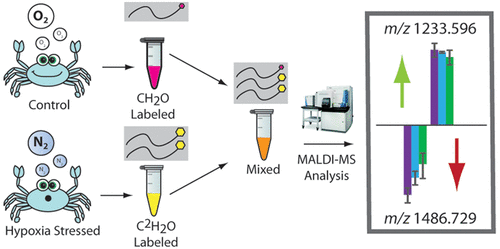当前位置:
X-MOL 学术
›
ACS Chem. Neurosci.
›
论文详情
Our official English website, www.x-mol.net, welcomes your
feedback! (Note: you will need to create a separate account there.)
Mass Spectrometric Profiling of Neuropeptides in Callinectes sapidus during Hypoxia Stress.
ACS Chemical Neuroscience ( IF 4.1 ) Pub Date : 2020-08-25 , DOI: 10.1021/acschemneuro.0c00439 Amanda R Buchberger 1 , Kellen DeLaney 1 , Yang Liu 1 , Nhu Q Vu 1 , Kylie Helfenbein 1 , Lingjun Li 1, 2
ACS Chemical Neuroscience ( IF 4.1 ) Pub Date : 2020-08-25 , DOI: 10.1021/acschemneuro.0c00439 Amanda R Buchberger 1 , Kellen DeLaney 1 , Yang Liu 1 , Nhu Q Vu 1 , Kylie Helfenbein 1 , Lingjun Li 1, 2
Affiliation

|
Oxygen (O2) is a critical component of life; without proper O2 levels, cells are unable to respire, meaning glucose cannot be utilized. Thus, hypoxia (low O2 levels) is a well-documented stressor, especially in aquatic environments. Neuropeptides are a major class of regulators for stress-induced responses; however, their global expression changes during stress are not well characterized due to the natural complexity of the nervous system. Beyond being a neurological model organism, crustaceans are regularly exposed to hypoxia, making them a relevant system for this study. Several neuropeptide families, including orcokinins, RFamides, and allatostatin A-types, show dynamic dysregulation due to hypoxic stress. In particular, the brain showed the most dynamic changes with a survival mechanism “switching” (i.e., significant increase to decrease) of neuropeptide content between moderate and severe hypoxia (e.g., NFDEDRSGFA, FDAFTTGFGHS, NRNFLRFamide, and APSGFLGMRamide). Globally, neuropeptides in different tissues appeared to exhibit unique expression patterns at the various severities of hypoxia, including LSSSNSPSSTPL and NFDEIDRSSFGF. Overall, this study provides clear evidence for the benefits of globally analyzing biomolecules and that neuropeptides play a critical role in how crustaceans adapt due to hypoxic stress.
中文翻译:

缺氧应激过程中saCallinectes sapidus中神经肽的质谱分析。
氧气(O 2)是生命的重要组成部分。没有适当的O 2水平,细胞将无法呼吸,这意味着无法利用葡萄糖。因此,缺氧(O 2低水平)是有据可查的压力源,尤其是在水生环境中。神经肽是应激诱导反应的主要调节因子。然而,由于神经系统的天然复杂性,它们在应激过程中的整体表达变化不能很好地表征。甲壳类动物不仅是神经系统模型生物,还经常暴露于低氧环境,使其成为本研究的相关系统。几个神经肽家族,包括orcokinins,RFamides和allatostatin A型,由于低氧应激而显示动态失调。特别是,大脑显示出最动态的变化,其中存活机制在中度和严重缺氧(例如NFDEDRSGFA,FDAFTTGFGHS,NRNFLRFamide和APSGFLGMRamide)之间“切换”(即,显着增加至减少)神经肽含量。在全球范围内 不同组织中的神经肽似乎在各种严重缺氧情况下均表现出独特的表达模式,包括LSSSNSPSSTPL和NFDEIDRSSFGF。总的来说,这项研究为全面分析生物分子的益处提供了明确的证据,并且神经肽在甲壳动物因缺氧应激而如何适应过程中起着至关重要的作用。
更新日期:2020-10-07
中文翻译:

缺氧应激过程中saCallinectes sapidus中神经肽的质谱分析。
氧气(O 2)是生命的重要组成部分。没有适当的O 2水平,细胞将无法呼吸,这意味着无法利用葡萄糖。因此,缺氧(O 2低水平)是有据可查的压力源,尤其是在水生环境中。神经肽是应激诱导反应的主要调节因子。然而,由于神经系统的天然复杂性,它们在应激过程中的整体表达变化不能很好地表征。甲壳类动物不仅是神经系统模型生物,还经常暴露于低氧环境,使其成为本研究的相关系统。几个神经肽家族,包括orcokinins,RFamides和allatostatin A型,由于低氧应激而显示动态失调。特别是,大脑显示出最动态的变化,其中存活机制在中度和严重缺氧(例如NFDEDRSGFA,FDAFTTGFGHS,NRNFLRFamide和APSGFLGMRamide)之间“切换”(即,显着增加至减少)神经肽含量。在全球范围内 不同组织中的神经肽似乎在各种严重缺氧情况下均表现出独特的表达模式,包括LSSSNSPSSTPL和NFDEIDRSSFGF。总的来说,这项研究为全面分析生物分子的益处提供了明确的证据,并且神经肽在甲壳动物因缺氧应激而如何适应过程中起着至关重要的作用。









































 京公网安备 11010802027423号
京公网安备 11010802027423号